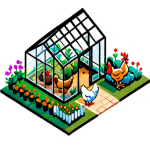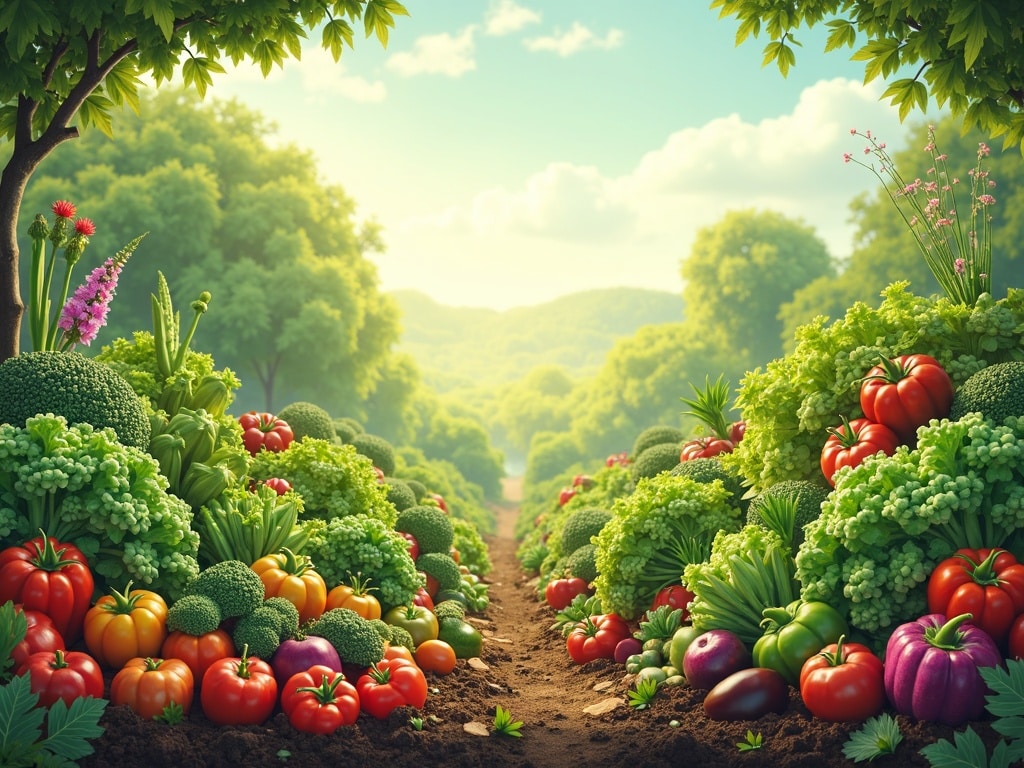The Lazy Gardener's Guide to Abundant Organic Vegetable Production
Imagine a garden overflowing with juicy tomatoes, crisp lettuce, and vibrant peppers – all without back-breaking labor or endless hours spent weeding. Sounds like a dream, right? It doesn't have to be. Lazy gardening, a mindful approach that prioritizes efficiency and minimal effort, is the secret to abundant harvests for those who prefer to relax more and toil less. This guide unveils the secrets of how to grow organic vegetables with ease, turning even the most novice gardener into a successful food producer.
Forget the image of perfectly manicured rows and hours of demanding chores. Lazy gardening embraces simplicity and sustainability, allowing you to enjoy fresh, organic produce with minimal input. It’s about working with nature, not against it, using clever strategies to reduce workload and maximize yields. Who wouldn't want to spend more time savoring the fruits (and vegetables) of their labor?
What Qualifies as Lazy Gardening & Why is it Appealing?
Lazy gardening isn't about being truly lazy; it's about being smart. It’s a philosophy that prioritizes efficiency, sustainability, and minimal intervention. It’s about setting up your garden in a way that it largely takes care of itself, reducing the need for constant attention and arduous tasks. Think less weeding, less watering, and less tilling.
- Reduced Physical Exertion: Less digging, tilling, and back-breaking work.
- Time Savings: Spend less time on chores and more time enjoying your harvest.
- Sustainability: Encourages eco-friendly practices like no-till gardening and water conservation.
- Accessibility: Makes gardening accessible to people with physical limitations or busy schedules.
- Stress Reduction: Gardening becomes a relaxing and enjoyable activity, not a stressful chore.
The appeal of lazy gardening lies in its ability to provide fresh, healthy, organic food without demanding all your free time and energy. It frees you to focus on the joy of gardening and the satisfaction of harvesting your own produce.
Easiest Organic Vegetables to Grow for Beginners
Starting with the right vegetables is crucial for success. Some vegetables are simply lower maintenance and more forgiving than others, making them ideal for lazy gardeners.
- Lettuce: Direct sow seeds and harvest individual leaves as needed.
- Radishes: Ready to harvest in just a few weeks, these are incredibly fast and easy.
- Zucchini: Prolific producers that require minimal care once established.
- Bush Beans: No staking required, and they provide abundant yields.
- Tomatoes (Determinate Varieties): Choose compact varieties that don't need extensive pruning or staking.
- Peppers: Relatively pest-free and productive with minimal effort.
- Kale: Hardy and resilient, kale can withstand neglect and still provide a bountiful harvest.
These vegetables are generally pest-resistant, require minimal fertilizing, and are relatively easy to harvest, making them perfect for beginner lazy gardeners.
Selecting an Ideal Location for a Lazy Organic Vegetable Garden
Location is paramount. Choosing the right spot can drastically reduce the amount of work required to maintain your garden.
- Sunlight: Most vegetables need at least 6-8 hours of direct sunlight per day. Choose a location that receives ample sunlight throughout the growing season.
- Water Access: Proximity to a water source simplifies watering. Consider installing a rain barrel to collect rainwater for irrigation.
- Soil Drainage: Avoid areas with standing water after rain. Well-draining soil is essential for healthy vegetable growth.
- Accessibility: Choose a location that's easily accessible for planting, harvesting, and general maintenance.
- Protection from Wind: Strong winds can damage plants and dry out the soil. Consider planting a windbreak or choosing a sheltered location.
Observing your property throughout the day to assess sunlight patterns and drainage will help you choose the optimal location for your lazy organic vegetable garden.
Best Soil Preparation Methods for Low-Effort Gardening
Traditional tilling can be labor-intensive and disruptive to soil ecosystems. Lazy gardening embraces no-till methods that build healthy soil with minimal effort.
- No-Till Gardening: Avoid tilling altogether. Instead, add organic matter to the soil surface and allow it to decompose naturally.
- Sheet Mulching (Lasagna Gardening): Layer cardboard or newspaper with organic materials like compost, straw, and leaves. This method smothers weeds, improves soil structure, and releases nutrients as it decomposes.
- Raised Beds: While requiring some initial effort to build, raised beds offer improved drainage, easier access, and less weeding.
- Composting in Place: Bury kitchen scraps and yard waste directly in the garden bed to enrich the soil and reduce waste.
These methods build healthy soil, suppress weeds, and reduce the need for fertilizers, all with minimal physical exertion.
Choosing the Right Organic Seeds & Seedlings for Your Region
Selecting the right seeds and seedlings is crucial for success. Choose varieties that are well-suited to your local climate and growing conditions.
- Heirloom Varieties: Often more resilient and flavorful than modern hybrids.
- Disease-Resistant Varieties: Choose varieties that are known to be resistant to common diseases in your area.
- Early-Maturing Varieties: Perfect for shorter growing seasons or gardeners who want to harvest quickly.
- Organic Seeds and Seedlings: Ensure that your plants are grown without synthetic pesticides or fertilizers.
- Buy Local: Support local nurseries and seed companies that offer varieties adapted to your specific region.
Consider starting seeds indoors for certain vegetables to get a head start on the growing season. However, for true lazy gardening, direct sowing seeds whenever possible simplifies the process.
Watering & Irrigation Techniques Minimizing Time & Water Waste
Efficient watering is key to conserving water and reducing the time you spend irrigating your garden.
- Soaker Hoses: Deliver water directly to the roots of plants, minimizing evaporation and water waste.
- Drip Irrigation: Another efficient method that delivers water slowly and directly to the root zone.
- Rain Barrels: Collect rainwater for irrigation, reducing your reliance on municipal water.
- Watering deeply and less frequently: Encourages deep root growth, making plants more drought-tolerant.
- Mulching: Helps retain soil moisture and reduces the need for frequent watering.
Automating your watering system with a timer can further reduce your workload and ensure consistent irrigation.
Effectively Using Organic Mulches to Suppress Weeds & Retain Moisture
Mulch is a lazy gardener's best friend. It suppresses weeds, retains moisture, regulates soil temperature, and adds organic matter to the soil as it decomposes.
- Straw: An excellent mulch for vegetable gardens.
- Wood Chips: Ideal for pathways and around perennial plants.
- Composted Leaves: A readily available and nutrient-rich mulch.
- Grass Clippings (Untreated): Provide nitrogen to the soil as they decompose.
- Cardboard or Newspaper: Layer underneath other mulches to suppress weeds effectively.
Apply a thick layer of mulch (3-4 inches) around your plants to reap its many benefits. Replenish as needed throughout the growing season.
Simplest Methods for Organic Pest and Disease Control
Preventing pests and diseases is far easier than treating them. Focus on creating a healthy and resilient garden ecosystem.

- Companion Planting: Plant beneficial herbs and flowers alongside your vegetables to attract pollinators and repel pests.
- Attracting Beneficial Insects: Encourage beneficial insects like ladybugs and lacewings by providing habitat and food sources.
- Crop Rotation: Rotate your crops each year to prevent the buildup of pests and diseases in the soil.
- Handpicking Pests: A simple and effective method for controlling small infestations.
- Neem Oil: A natural insecticide and fungicide that can be used to treat a variety of pests and diseases.
Regularly inspect your plants for signs of pests or diseases and take action promptly to prevent problems from escalating.
Utilizing Companion Planting to Benefit Your Vegetables Naturally
Companion planting is the strategic placement of different plants together to benefit one another. Some plants can repel pests, attract pollinators, improve soil nutrients, or provide shade for their companions.
- Tomatoes & Basil: Basil repels tomato hornworms and improves tomato flavor.
- Carrots & Onions: Onions repel carrot flies, and carrots repel onion flies.
- Lettuce & Marigolds: Marigolds repel nematodes and other pests that can damage lettuce.
- Beans & Corn: Beans fix nitrogen in the soil, benefiting the corn, while the corn provides support for the beans to climb.
- Cucumbers & Nasturtiums: Nasturtiums repel cucumber beetles and other pests.
Researching which plants are beneficial companions for your specific vegetables can significantly reduce pest problems and improve overall garden health.
Harvesting Techniques to Maximize Yield & Minimize Plant Stress
Harvesting your vegetables properly can encourage continued production and minimize stress on the plants. Harvesting Delicious Lettuce From the Garden: A Step-by-Step Guide can provide some insight into maximizing yields.
- Harvest Regularly: Harvesting vegetables as they ripen encourages the plant to produce more.
- Use Sharp Tools: Use sharp knives or scissors to avoid damaging the plant.
- Harvest at the Right Time of Day: Harvest leafy greens in the morning when they are crisp and hydrated.
- Handle with Care: Avoid bruising or damaging the vegetables during harvest.
- Deadhead Flowers: Remove spent flowers to encourage continued flowering and fruit production.
Knowing when and how to harvest each vegetable will help you maximize your yield and enjoy the freshest possible produce.
Succession Planting for a Continuous Harvest Throughout the Growing Season
Succession planting is the practice of planting successive crops of the same vegetable at intervals throughout the growing season to ensure a continuous harvest.
- Plant every 2-3 weeks: Plant a new batch of lettuce, radishes, or other quick-growing vegetables every 2-3 weeks to ensure a steady supply.
- Use early and late-maturing varieties: Plant both early and late-maturing varieties of the same vegetable to extend the harvest season.
- Interplant short-season crops with long-season crops: Plant radishes or lettuce between rows of tomatoes or peppers to maximize space and yield.
- Replant after harvesting: As soon as you harvest a crop, replant with another fast-growing vegetable.
Succession planting ensures a continuous supply of fresh vegetables throughout the growing season, keeping your table full of delicious, homegrown produce.
Simplest Methods for Composting Kitchen & Yard Waste
Composting is a great way to recycle kitchen and yard waste into valuable soil amendment for your garden. It reduces waste, enriches the soil, and reduces the need for fertilizers.
- Simple Compost Pile: Simply pile up kitchen scraps and yard waste in a designated area and let it decompose naturally.
- Compost Bin: A compost bin helps contain the compost and speed up the decomposition process.
- Worm Composting (Vermicomposting): Use worms to break down kitchen scraps and produce nutrient-rich compost.
- Keyhole Garden: A unique method that creates a raised bed with high-efficiency composting placed at the center.
Aim for a balance of green (nitrogen-rich) and brown (carbon-rich) materials in your compost pile. Turn the pile regularly to aerate it and speed up decomposition.
Common Lazy Gardening Mistakes & How to Avoid Potential Pitfalls
Even lazy gardening requires some planning and attention to detail. Here are some common mistakes to avoid:
- Neglecting Soil Preparation: Healthy soil is the foundation of a successful garden. Don't skip the soil preparation step.
- Ignoring Watering Needs: Even drought-tolerant vegetables need water, especially during dry spells.
- Failing to Mulch: Mulch is essential for weed control and moisture retention.
- Overcrowding Plants: Give your plants enough space to grow and thrive.
- Ignoring Pests & Diseases: Monitor your plants regularly and take action promptly if you spot any problems.
By avoiding these common mistakes, you can ensure a successful and rewarding lazy gardening experience.
Advanced Lazy Gardening Techniques to Consider for Future Growth
Once you've mastered the basics of lazy gardening, you can explore more advanced techniques to further simplify and improve your gardening practices.
- Hugelkultur: Building raised beds filled with logs and branches, which slowly decompose and provide long-term nutrients and moisture.
- Permaculture Design: Designing your garden to mimic natural ecosystems, creating a self-sustaining and low-maintenance landscape.
- Grafting: Grafting desirable varieties onto hardy rootstocks to improve disease resistance and yield.
- Seed Saving: Saving seeds from your best plants to ensure a continuous supply of adapted varieties.
These advanced techniques can take your lazy gardening to the next level, creating a truly self-sufficient and thriving garden ecosystem.
Preserving Your Abundant Harvest with Minimal Effort
When your garden is overflowing with produce, you'll need to preserve the excess to enjoy it year-round. Here are some simple methods for preserving your harvest with minimal effort:
- Freezing: A quick and easy way to preserve many vegetables. Simply blanch, cool, and freeze in airtight containers.
- Drying: Removing moisture from vegetables to prevent spoilage. Can be done in a dehydrator, oven, or even in the sun.
- Fermenting: A traditional method of preserving vegetables using beneficial bacteria. Creates delicious and nutritious fermented foods like sauerkraut and kimchi.
- Storing: Some vegetables, like potatoes and onions, can be stored for months in a cool, dark, and dry place.
Choose the preservation method that best suits your needs and enjoy your homegrown vegetables throughout the year.
Conclusion
Lazy gardening isn't about shirking responsibility; it's about working smarter, not harder. By embracing these techniques, you can create a thriving organic vegetable garden that provides you with an abundant harvest with minimal effort. So, ditch the back-breaking labor, embrace the lazy gardener philosophy, and enjoy the fruits (and vegetables) of your relaxed labor!

